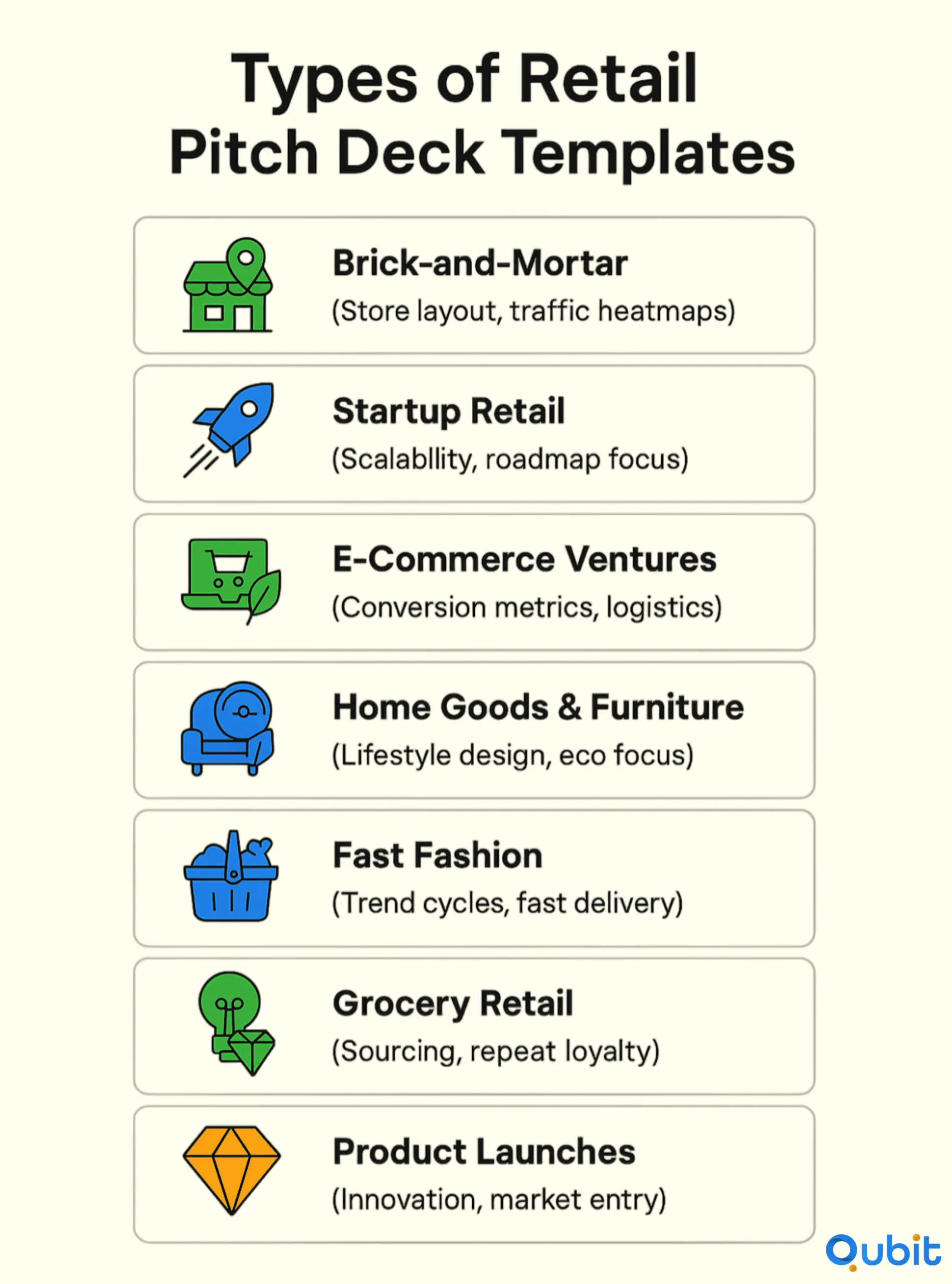Retail founders face a unique challenge when presenting their ideas to investors: standing out in a competitive market while showcasing clear growth potential. With global ecommerce sales projected to reach $8.3 trillion by 2025, the retail sector offers immense opportunities for innovation and expansion. A well-structured retail pitch deck can help you articulate your vision, highlight market opportunities, and secure investor confidence.
This blog aims to guide you through the essentials of creating a compelling, data-driven pitch deck tailored for retail startups. From integrating key statistics like the 15% rise in retail tech funding in Q4'23 to emphasizing strategies such as retail media monetization, we’ll explore actionable insights to elevate your investor presentation. For a deeper dive into structuring your slides, check out our article on retail startup pitch deck slides.
Let’s jump right in!
Winning Retail Startup Pitch Deck Templates
Crafting a compelling pitch deck is essential for retail businesses aiming to secure investor interest. With tailored retail pitch deck templates, businesses can address diverse market segments while showcasing their unique value propositions. Whether you're launching a startup, scaling an e-commerce venture, or revitalizing a brick-and-mortar store, specialized templates can make all the difference.
Why Tailored Pitch Decks Matter
Retail models vary significantly, from fast fashion to luxury goods, and each demands a unique approach to storytelling and data presentation. A one-size-fits-all deck risks missing critical nuances that investors look for. For example, an e-commerce pitch deck might emphasize digital scalability and customer acquisition strategies, while a grocery pitch deck would focus on supply chain efficiency and local market penetration.
Tailored templates not only enhance credibility but also demonstrate a deep understanding of the market. They allow businesses to integrate precise market sizing metrics, such as TAM (Total Addressable Market), SAM (Serviceable Available Market), and SOM (Serviceable Obtainable Market), which are crucial for contextualizing growth opportunities. For further insights on market sizing, an analysis of retail market sizing tam sam som demonstrates how segmenting the market clarifies opportunity scales, thereby contextualizing your deck’s market opportunity section.
Types of Retail Pitch Deck Templates

1. Brick-and-Mortar Retail
Brick-and-mortar businesses thrive on customer experience and location strategy. Templates for this model should highlight foot traffic analytics, store design innovations, and operational efficiency. Incorporating visuals like heatmaps and customer flow diagrams can enrich the narrative.
2. Startup Retail
Startups often need to convey scalability and innovation. A startup pitch deck template should focus on disruptive business models, early traction, and funding milestones. Investors are drawn to clear roadmaps and projections that showcase exponential growth potential.
3. E-Commerce Ventures
E-commerce businesses require templates that emphasize digital marketing strategies, logistics, and customer retention metrics. Interactive slides showcasing conversion rates, cart abandonment solutions, and omnichannel strategies can set your deck apart.
4. Home Goods and Furniture
For home goods retailers, templates should focus on product design, sustainability, and customer lifestyle integration. Highlighting partnerships with designers or eco-friendly initiatives can resonate with investors.
5. Fast Fashion
Fast fashion decks should emphasize speed-to-market, trend forecasting, and supply chain agility. Visual storytelling is key here—use dynamic slides to showcase seasonal collections and market trends.
6. Grocery Retail
Grocery templates should prioritize supply chain efficiency, local sourcing, and community engagement. Investors often look for data on repeat customers and loyalty programs in this sector.
7. Product Launches
Launching a new product requires a pitch deck that focuses on innovation, market demand, and competitive differentiation. Templates should include slides for product features, customer testimonials, and pre-launch buzz.
8. Luxury Retail
Luxury retail decks should emphasize exclusivity, brand heritage, and customer experience. High-quality visuals and storytelling are essential to convey the aspirational value of the brand.
Design Tips for Retail Startup Pitch Decks
A well-designed pitch deck is as much about aesthetics as it is about content. To enhance visual storytelling, consider these tips:
- Use Consistent Branding: Align colors, fonts, and imagery with your brand identity.
- Incorporate Interactive Elements: Tools like Storydoc allow you to create interactive decks effortlessly. Click this link to create an interactive pitch deck with Storydoc's free wizard in minutes.
- Focus on Data Visualization: Charts, graphs, and infographics can make complex data more digestible.
For additional design guidance, a review of retail pitch deck design tips offers insight into the visual elements that can enrich your presentation, blending aesthetics with a compelling story.
The Role of Retail Tech Trends
Retail technology is evolving rapidly, and integrating these trends into your pitch deck can demonstrate forward-thinking strategies. Highlighting innovations like AI-driven personalization, inventory automation, and augmented reality shopping experiences can captivate investors.
Interactive Resources for Retail Startup Pitch Deck Creation
Interactive tools can streamline the process of creating impactful pitch decks. Platforms like Storydoc offer customizable templates tailored to retail models.
Strategies for an Creating an Impactful Retail Startup Pitch Deck
Crafting a retail pitch deck that captivates investors requires a blend of storytelling, data-driven insights, and visual engagement. With the retail analytics market projected to grow at a 17.14% CAGR through 2034, founders must present their ideas with precision and creativity to stand out. This section explores actionable strategies to create a high-impact pitch deck, emphasizing interactive storytelling, structured slide design, and neuro-engagement techniques.
1. Build a Compelling Narrative
A strong narrative is the backbone of any successful pitch deck. Investors connect with stories that are relatable, emotional, and solution-oriented. Drawing inspiration from Dollar Shave Club's $1B Exit, use their problem-solution framework to structure your story arc. Begin by identifying the pain points in the retail industry, then showcase how your product or service addresses these challenges effectively.
Additionally, consider incorporating an emotional founder story, as demonstrated by Warby Parker's Storytelling Success. A personal, authentic narrative can foster trust and drive investor interest. For example, sharing the journey behind your brand’s inception can highlight your passion and commitment to solving industry-specific problems.
2. Prioritize Data-Driven Insights
Investors value numbers that validate your business model. Incorporate retail analytics to demonstrate market potential and operational efficiency. Highlight how data-driven insights can differentiate your pitch deck in the eyes of investors, especially given the rapid growth of the retail analytics market.
For instance, showcasing AI predictive models can refine product strategies and optimize inventory management. By integrating AI-Driven Inventory Optimization, you can illustrate how advanced algorithms streamline operations and boost profitability. These insights not only add credibility but also position your business as forward-thinking and innovative.
3. Design Slides for Maximum Impact
Visual design plays a crucial role in retaining investor attention. Use structured slide layouts that balance text, visuals, and whitespace. Tools like Storydoc can enhance your pitch deck with robust visuals and interactive elements. Storydoc also allows you to track investor engagement, helping you refine your presentation based on real-time feedback.
Focus on clarity and simplicity. Avoid cluttered slides by limiting text and using high-quality visuals to convey complex ideas. For example, charts and graphs can effectively present financial projections, while infographics can simplify operational workflows.
4. Showcase Financial Projections
A perspective on retail startup financial projections underlines the role of detailed numerical insights and unit economics in reinforcing the analytical depth of your pitch deck. Investors want to see clear, realistic financial forecasts that demonstrate scalability and profitability. Break down your revenue streams, cost structures, and growth projections into digestible formats.
Use case studies or benchmarks to validate your projections. For instance, comparing your expected growth trajectory with industry leaders can provide context and build confidence in your business model.
5. Integrate Neuro-Engagement Techniques
Engage your audience on a deeper level by incorporating neuro-engagement techniques. These methods tap into cognitive triggers that enhance memory retention and emotional connection. For example, use storytelling elements like suspense, surprise, or humor to keep investors intrigued.
Additionally, color psychology can influence investor perception. Use bold, contrasting colors to highlight key points, and softer tones for background elements to create a visually appealing experience.
6. Highlight Industry Trends and Case Studies
Demonstrating awareness of industry trends can strengthen your pitch deck’s credibility. Mention the projected growth of the retail analytics market and how your business aligns with this trajectory. Use case studies like Dollar Shave Club and Warby Parker to illustrate proven strategies and outcomes.
For instance, if your business model incorporates AI, emphasize how predictive analytics can refine product strategies and improve customer experiences. This positions your brand as innovative and adaptable to emerging technologies.
7. End with a Strong Call to Action
Conclude your pitch deck with a clear and compelling call to action. Whether it’s securing funding, forming partnerships, or exploring new markets, ensure your final slide leaves a lasting impression.
Conclusion
Focusing on data-driven insights and tailoring your templates to specific investor expectations, will help you can create presentations that stand out. A narrative-driven approach, combined with investor-ready visuals, ensures your pitch deck not only captures attention but also builds confidence in your retail startup’s potential.
For those seeking advanced strategies, an exploration of retail startup fundraising strategies reveals how your pitch deck connects with broader funding narratives, illustrating a comprehensive view of investment approaches.
If you're ready to engage with investors, we encourage you to explore our Pitch Deck service. Let us help you take the next step in securing the funding your startup deserves.
Key Takeaways
- A tailored retail pitch deck significantly enhances investor engagement.
- Specialized templates for diverse retail models improve clarity and focus.
- Data-driven insights and case studies add credibility to your presentation.
- Interactive storytelling and clear financial projections are essential.
Frequently asked Questions
What should be included in a retail pitch deck?
A well-rounded retail startup pitch deck should include a concise problem statement, detailed market opportunity analysis, financial projections, and a compelling team narrative. Supporting these elements with data and case studies can further strengthen your presentation.


 Back
Back



